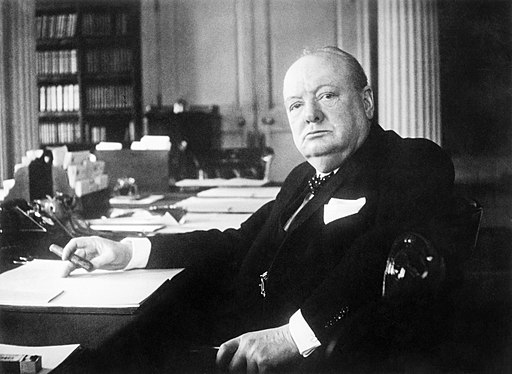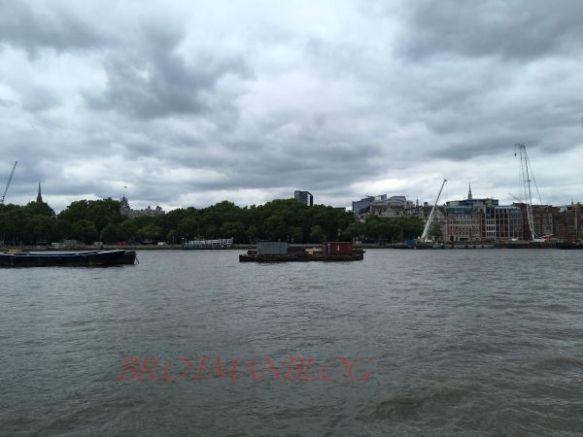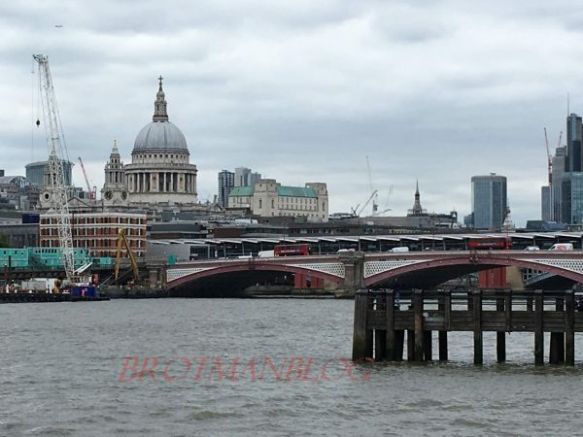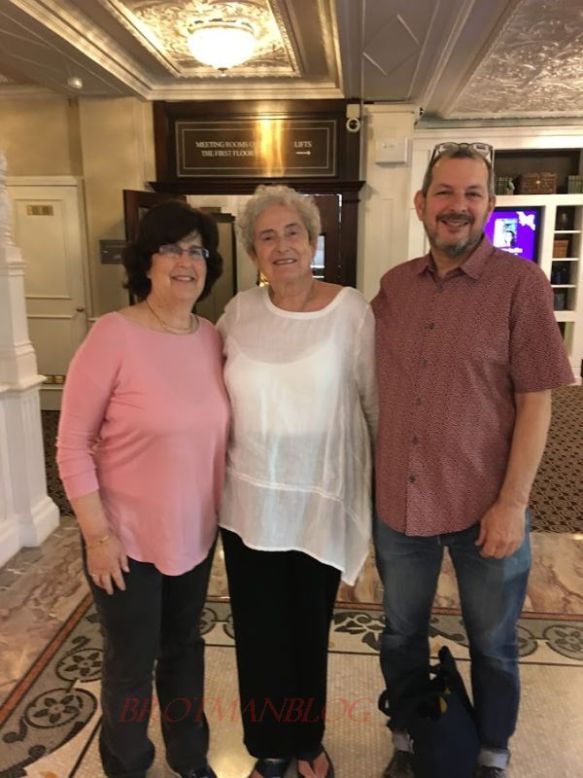Our last day in England was as action-packed as our first two days in London. We had planned to go to Churchill’s War Rooms. Several friends had recommended it, and after seeing The Darkest Hour, we were both very interested in learning more about Winston Churchill and his role in World War II. We had passed the site the day before and noted the very, very long line of people on the sidewalk and decided that we’d better get there as early as we could.
We showed up at 9:10, knowing that the museum didn’t open until 9:30. There was already a line ahead of us—perhaps about thirty people. What we hadn’t realized was that it would have been possible to buy tickets ahead of time for a set time on the priority line, but now it was too late. As we stood outside waiting, the line behind us grew longer and longer, stretching down the block almost to the corner by the time the doors opened at 9:30. Then we had to wait as the priority ticketholders entered. Every ten minutes or so they would allow in more people, including a few from the regular line.
We finally entered at 10:20, saying to each other, “This had better be worth the wait.” It was. Without question.
We spent two hours underground at the exhibit. The audioguides were excellent, providing clear directions on where to go and lots of information about what we were seeing as well as interviews with some of those who worked in the war rooms with Churchill. It was a fascinating tour. Seeing the spaces that were recreated in the movie and realizing that these men and women had spent days and nights during the long years of the war burrowed beneath the ground, doing intelligence work and collecting information about the war’s progress, made us appreciate even more Churchill’s leadership and commitment to winning the war.

Winston Churchill as Prime Minister https://upload.wikimedia.org/wikipedia/commons/5/58/Winston_Churchill_As_Prime_Minister_1940-1945_MH26392.jpg
Cecil Beaton (Public domain)
There is one very large gallery devoted to an exhibit about Churchill’s life. For some reason they decided to start with the war years, then the post-war years and his death, and then his early years as a child, a young adult, and a politician. I found that room a bit confusing and overwhelming. Maybe because I am such a linear person and like things to be in chronological order. I most enjoyed hearing some of Churchill’s speeches in his own voice and also seeing pictures of him and his family as a boy and then as a father and husband.
We finally emerged from the dark around noontime and were grateful to see sunlight, although it was a cloudy and gray day. We walked over the Westminster Bridge. Well, we tried to walk. The throngs of people made it as crazy as being in Times Square before theaters open. You could barely move. We were heading to the Tate Modern, which is on the other side of the Thames. When we finally managed to get away from the crowds, it was quite a relief.
After a quick lunch, we continued our walk to the Tate Modern. We enjoyed the walk along the river with the London skyline in view—we could see St Paul’s Cathedral and all the modern skyscrapers that we had seen the day before, but now from a distance with the river in the foreground.
We finally reached the Tate Modern, and it is an imposing structure. Once a power station, it was converted to a museum and opened in 2000. I can’t say that I found it a terribly inviting building—it still looks more like a power station than a museum, although there are glass additions on top of the old building.
Entering the building felt a bit like entering a huge train station—a very large open hall descending down towards the ticket booth and museum itself.
We went to two of the exhibits, the first being Artist and Society, which focused on how artists use their art to comment on society. Some of those works were very provocative—like the collection of firehoses attached to each other to evoke the hoses used to spray African American protesters during the civil rights movement in the US or a series of photographs showing the demolition of buildings in the name of urban renewal. But some just left me cold, like the one of strange large forms just strewn on the floor.
The second exhibit we saw was more traditional and included works of artists who were more familiar, such as Picasso, Dali, and Rothko. It focused on the artistic process itself. I enjoyed that exhibit more than the first because I tend to be more conventional in my idea of what is art and prefer art that is more about aesthetics than politics.
We wanted to take the elevator up to see the observatory on the tenth floor. But the lines were too long, and we gave up. I think we’d just had enough of crowds for the day.
Our last evening in London was much less hectic than the day. We took an Uber to Covent Garden and had a fabulous sushi dinner at Sticks and Sushi. Then we walked from there to St Martin-in-the Fields Church for a concert of Vivaldi, Mozart, and Purcell. The music was soothing and relaxing, and the setting quite beautiful.



 For our last morning in England, we had the wonderful treat of meeting two of my cousins—Annette, my fourth cousin, once removed, and Mark, my fifth cousin. Annette and Mark are related to me through my Seligmann family. We are all descended from Jakob Seligmann and Martha Mayer, my four-times great-grandparents. Mark and Annette descend from Jakob and Martha’s daughter Caroline who married Moses Morreau, and I descend from Jakob and Martha’s son Moritz. We had a delightful time together—sharing family history and our own stories. Mark and I have now continued to share and explore our mutual family history.
For our last morning in England, we had the wonderful treat of meeting two of my cousins—Annette, my fourth cousin, once removed, and Mark, my fifth cousin. Annette and Mark are related to me through my Seligmann family. We are all descended from Jakob Seligmann and Martha Mayer, my four-times great-grandparents. Mark and Annette descend from Jakob and Martha’s daughter Caroline who married Moses Morreau, and I descend from Jakob and Martha’s son Moritz. We had a delightful time together—sharing family history and our own stories. Mark and I have now continued to share and explore our mutual family history.
And after saying goodbye to my cousins, we packed our bags and headed for Heathrow for the flight back to the US. I was quite sad to leave. It had been a perfect vacation with the right mix of relaxation, exercise, gorgeous views, art and culture, history, and friendly people. I was in no way ready for it to end.
But it did, and now I have found great pleasure in recreating and remembering it all through my blog. I hope you have enjoyed my travelogue as well. Thanks for coming along.
Next—a return to the story of the children of Henry Goldsmith.







Having struggled to stay organized all my life, I also tend to be linear in my thoughts. I can understand why you did not like the presentation on Churchill’s life. I feel the same when it comes to art. Too much abstraction and paintings with a focus on the ugly turn me off. I can see how attending the Four Seasons concert brought joy, Amy. Best wishes! Peter
LikeLiked by 1 person
Sounds like we agree on many things! Thanks, Peter.
LikeLiked by 1 person
Thanks for sharing your vacation with me….I loved my visit to London through your eyes!
LikeLiked by 1 person
Thanks, Sharon.
LikeLike
The War Rooms are on our bucket list too – and wow, Vivaldi at St. Martin-in-the-Fields – how perfect!!
LikeLiked by 1 person
It was!
LikeLike
Looks like you had an amazing time in England 😊 I was in Tate Modern myself earlier this week, on the 11th June. I saw all of the odd pieces of art too 😳
Hope you arrived home well
LikeLiked by 1 person
We did! What a great country you have there. And I did have mixed feelings about the Tate Modern, but was glad we saw it. 🙂
LikeLiked by 1 person
Hi Amy, The Churchill War Museum can be overwhelming and it takes time to process all the information there.
Sounds like you had the most amazing time at The Vivaldi concert and good to meet and spend time with your Seligmann cousins too. What an English adventure you had, and thank you for sharing your experiences with us. As ever great photo’s.
LikeLiked by 1 person
You live in a wonderful country with so much history and beauty. We truly loved our time there. Thank you, Shirley. Now you need to come to NEW England. 🙂
LikeLike
Who knows Amy, maybe in a couple of years we will be able to travel to New England. 👍
LikeLiked by 1 person
I hope so!
LikeLike
How wonderful to meet your cousins, Amy!
Husband tried to get me to watch The Darkest Hour with him, and I kept refusing after not liking the beginning of it. Then I agreed and our DVR had lost it :(. So now that I can’t watch it, I want to watch it.
LikeLiked by 1 person
We really enjoyed it. So well done. I am sure you can stream it.
LikeLiked by 1 person
Haha. We don’t do newfangled TV.
LikeLiked by 1 person
Wow, we don’t even have a dvd player any more. We barely watch broadcast TV or even regular cable. Almost everything we watch is through a streaming service.
LikeLiked by 1 person
Husband is a Luddite AND we have an old fashioned smart house system that is very difficult to work with at this point. I could Netflix on my computer but I Don’t want to watch movies or TV that way.
LikeLiked by 1 person
I agree—I don’t watch on my laptop or phone. And we have no smart house! 🙂
LikeLiked by 1 person
Hubs insisted on setting up a smart house when we moved because of the reconstruction of my foot and the chance that the tumor could come back. He wanted to make it easier for me. It’s been a nightmare.
LikeLiked by 1 person
I don’t even know what it would mean to have a smart house. We don’t even have one of those Alexa things.
LikeLiked by 1 person
Trust me, 12 year old technology is not Alexa. hahaha Regular remotes, but you can work it in other rooms from the kitchen.
LikeLiked by 1 person
So you can’t just tell it to play music or lower the temperature? I prefer walking ten feet to do either!
LikeLiked by 1 person
🤣 no! It doesn’t respond to voice. And the music part has never worked.
LikeLiked by 1 person
Amy, I’m leaving Wed. Night for London, and you’ve given me many ideas for my trip, like the priority entry for Churchill’s War room. We have to figure out our relationship one of these days. I recall that there are Altstedters in your husband’s family ((my mother’s paternal side) but I believe I also share DNA with your brother on my paternal side. I think Seligman is also a name on that side going back a few generations. I’ll get back to you on that. In London, I’ll be meeting a third cousin on my mother’s maternal side. Isn’t this fun?
LikeLiked by 1 person
Have a wonderful time in London! Have you been there before? We had a great time—but be careful crossing the streets!
I think we share bits of DNA from all different sides, but whether we will ever get far back enough in our family trees to find the common ancestors seems a long shot. One day I will get Harvey to do a DNA test. But he is just not interested. Sigh….
LikeLike
I’ve never been to England and have enjoyed your visit. I have to agree with both you and Peter about being linear – chronological order is easiest for the genealogist/researcher. Meeting the cousins at the end must have been the cherry on top of the cream.
LikeLiked by 2 people
Glad to know that there are others who like things to be linear. All of us left-brain, organized people looking for patterns. 🙂
Maybe you should get to England before they abandon the EU and you need to get your passports checked at the border. 😦
LikeLiked by 1 person
Amy, I see a bit of a resemblance between you and Annette. Glad you got to the lovely St. Martin in the Fields church. When I listened to WQXR while I lived in New York, I heard several concerts that were given there. A few featured period instruments. The string instruments from previous times sound much sweeter and less metallic than the modern ones. Anyway, I hope your friendship with Annette and Mark continues.
LikeLike
All I can say is wow. What a great trip.
LikeLiked by 1 person
Thanks, Charles—it really was!
LikeLike
What a wonderful visit you had – thank you for sharing it. I’ve never been to England (or Europe, for that matter) so it was great to get some tips. I would live to visit the Churchill museum.
LikeLiked by 1 person
I hope you get to go some day. It was a wonderful experience.
LikeLike
So glad you enjoyed your time here – weather and all. I’m sure you heard the anecdote about the Tate Modern, how somebody accidentally dropped their spectacles on the floor and it was a day before anyone realised they were not an exhibit?
LikeLiked by 1 person
That’s great!! And so true. 😆
LikeLiked by 1 person
Pingback: A Morreau Family Update: In Memory of Patrick Morreau 1934-2019 | Brotmanblog: A Family Journey